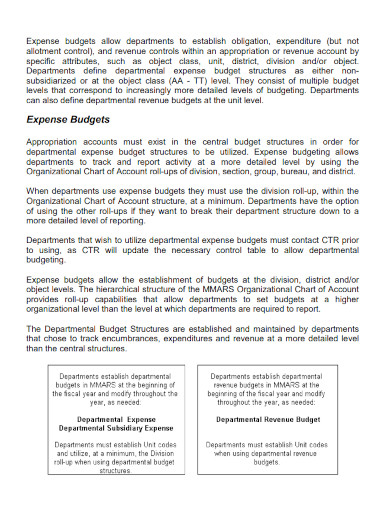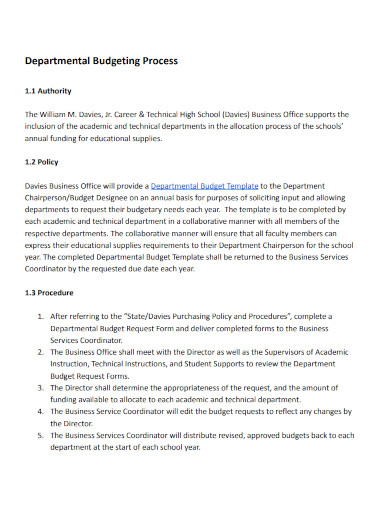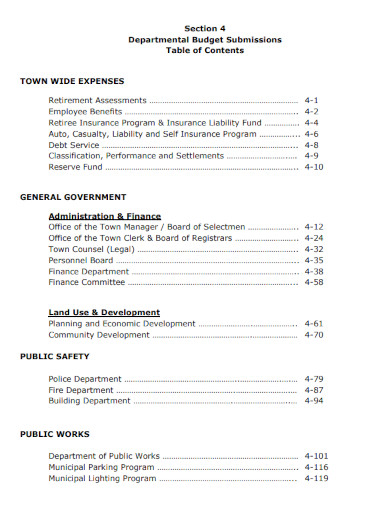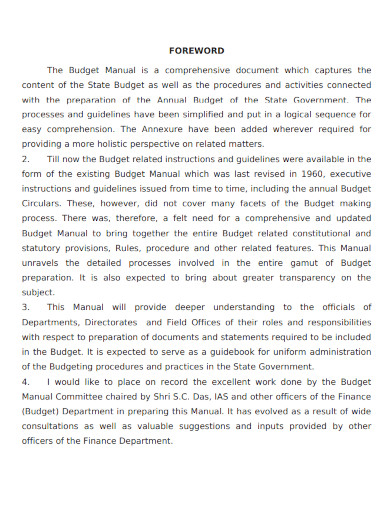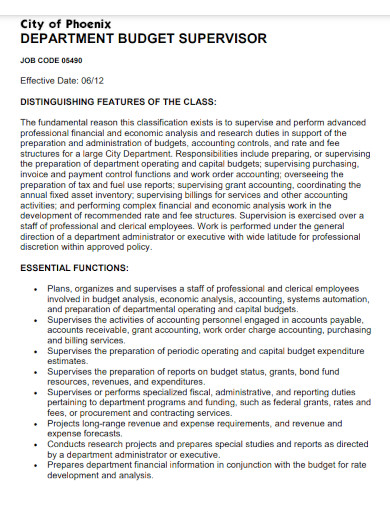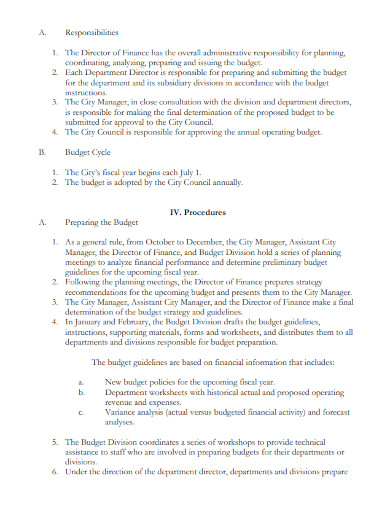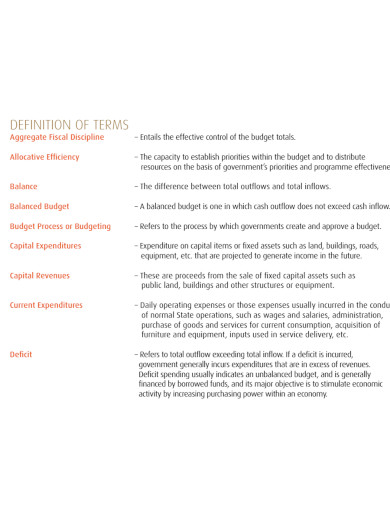Department budgeting at the department level allows for greater control over expenditure, enabling teams to do more granular analyses of their company performance. The capacity to control event risk and determine which business sectors are profitable and which are not are two of the many benefits. It is also possible that this will enable teams to identify bottlenecks more quickly than they would if they were working with a single budget for the entire organization. In the grand scheme of things, this method can assist businesses in being financially stable by ensuring that there is always sufficient cash on hand to pay employee wages, fund future business projects, and make timely payments to exclusive suppliers.
10+ Departmental Budget Samples in PDF
1. Departmental Budget Structures Overview
2. Departmental Budgeting Process
3. Non Departmental Budget Summery
4. Departmental Budget Submissions
5. Departmental Budget Manual
6. Departmental Budget Information
7. Non Departmental Budget
8. Department Budget Supervisor
9. Non Departmental Budget Expenditures Budget
10. Departmental Budget Development Process
11. Departmental Budget Analysis Manual
What is Departmental Budget?
A departmental budget is a budget for the next calendar quarter or fiscal year outlined in the department’s budget. Managing a budget for your department is analogous to the management of a budget for a family. However, a household budget with a few additional stakeholders and moving elements is added into the mix. Keeping this in mind, those in charge of drafting the budget for the department need to begin with a sound foundation. To accomplish this, a list of objectives relating to income statements and expenses, overhead, predicted sales commission and expected material cost estimate must be formulated. In addition to this, you should make sure that there is sufficient wiggle room in case things do not go according to plan.
How To Make a Departmental Budget?
You can follow the steps outlined below if you need to create a budget for a project, initiative, department, or even the entire business. It can be of assistance to you whenever you are unsure of how to begin working on the budget for your department.
1. Understand The Organization’s Goals
It is essential to have explicit knowledge of the objectives your company plans to strive toward over the period that the budget will cover before beginning to construct it. If you have a clear grasp of those goals, you will be able to create a budget that supports them and helps you achieve them.
2. Create an Income Forecast
To estimate how much money you have available for business expenses, you must first calculate your income and cash flow for the period in question as accurately as possible. The difficulty level of this process will be directly proportional to the complexity of the organization you represent.
3. Identify Your Expenses
After you know how much money you anticipate making throughout the period, the next step is to calculate how much money you will spend during that time. Three primary types of costs are associated with this procedure: fixed costs, variable charges, and one-time expenses. The term “fixed costs” refers to any outlays sustained throughout time and does not see significant shifts from one week to the next or one month to the next.
4. Find Out If You Have a Budget Surplus or a Budget Deficit
When you’ve finished tallying up all of your income and spending, you can include them into your financial plan. At this point, you will evaluate whether or not the revenue you anticipate will be sufficient to meet all of your expenses. You will have a surplus in your budget if you have more income coming in than you need to cover all of your costs.
What are the four processes involved in putting together a budget?
The phases of preparation, approval, implementation, and evaluation that make up the budget cycle for a small firm are as follows: The process that begins with the design or preparation of a budget and ends with its assessment is known as the budget cycle.
What is the annual budget for the department?
A business’s anticipated earnings and expenditures are mapped out in detail in the form of an annual budget.
Which of these three primary categories best describes your budget?
The Surplus Budget, the Balanced Budget, and the Deficit Budget are the three different types of annual government budgets that are based on estimates.
The nature of an organization and its financial objectives play a role in determining who is in charge of developing a budget for that organization. An entrepreneur or small business owner, for example, is likely to establish an organizational budget on their own. In the meantime, a larger corporation may delegate the task of creating a budget for the entire company to a member of the accounting department.
Related Posts
FREE 10+ Personal Budget Planner Samples in MS Word | MS Excel | Google Docs | Google Sheets | Apple Numbers | Apple Pages | PDF
FREE 5+ Yearly Budget Planner Samples in PDF | XLS
FREE 10+ Expense Budget Samples in MS Word | Google Docs | Google Sheets | MS Excel | PDF
FREE 4+ Vacation Budget Planner Samples in PDF
FREE 10+ Budget Outline Samples in PDF | MS Word
FREE 10+ Conference Budget Samples in MS Word | MS Excel | Google Docs | Google Sheets | Apple Pages | PDF
FREE 10+ Monthly Budget Worksheet Samples in PDF | MS Word | Google Docs | Google Sheets | Excel
FREE 10+ Monthly Project Budget Samples in MS Word | MS Excel | Google Docs | Google Sheets | PDF
FREE 10+ Corporate Budget Samples in MS Word | MS Excel | Google Docs | Google Sheets | PDF
FREE 9+ Primary School Budget Samples in MS Word | Google Docs | Google Sheets | MS Excel | PDF
FREE 10+ Operational Budget Samples in PDF | DOC
FREE 5+ Budget Layout Samples in PDF
FREE 6+ Paycheck Budget Samples in PDF | MS Word
FREE 10+ Architecture Budget Samples in PDF
FREE 10+ Capital Budget Samples in PDF | MS Word | Google Docs | Google Sheets | Excel | Apple Numbers | Apple Pages

